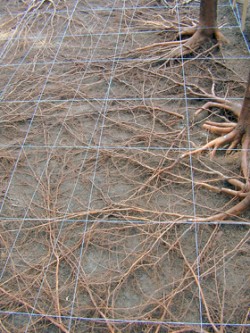Kořenové srůsty, které vznikají mezi kořeny jednoho jedince, různých jedinců stejného nebo i různých druhů, umožňují přenos cukrů, hormonů a dalších látek mezi stromy. Jejich prostřednictvím však dochází také k šíření patogenů. Ekologické dopady existence kořenových srůstů jsou v současnosti předmětem bádání.
Čermák J., Gašpárek J., Adamčík L., Culek I., Čermák M., Ulrich R. (2005): Vizualizace kořenových systémů pomocí supersonického proudu vzduchu. In. Neruda J. (ed.): Metody pro zlepšení determinace poškození kořenů stromů ve smrkových porostech vyvážecími traktory. I. Výběr a ověření metod. Monografie. Brno, leden 2005. p. 7-10
Graham B.F., Bormann F.H. (1966): Natural root grafts. Bot. Rev. 32, 255-292.
Külla T., Lõhmus K. (1999): Influence of cultivation method on root grafting in Norway spruce (Picea abies (L.) Karst.). Plant and Soil 217: 91-100
Saveljeva L.S. (1969): Grafting of Tree Root Systems. Lesnaja Promychlennost Publisher, Moscow, USSR. 72 p.
Stenlid J. (1986): Biochemical and Ecological Aspects of the Infection Biology of Heterobasidion annosum. PhD Thesis. Swedish University of Agricultural Science, Uppsala, Sweden. 37 p.
Sutton R.F. (1969): Form and Development of Conifer Root Systems. Commonwealth Agricultural Bureaux; Farnham Royal; England. p. 131
Root adhesions, which can develop between roots of the same plant, different plants of the same species or different species, enable the transfer of sugar, hormones and other substances between trees. However, pathogens can also be spread in this way. The ecological consequences of the existence of root adhesions are currently studied.
 Odkrytý kořenový systém 40letého porostu smrku ztepilého (Picea abies) nedaleko Brna. Pro smrk ztepilý je typický povrchový kořenový systém. Foto R. Gebauer / © R. Gebauer
Odkrytý kořenový systém 40letého porostu smrku ztepilého (Picea abies) nedaleko Brna. Pro smrk ztepilý je typický povrchový kořenový systém. Foto R. Gebauer / © R. Gebauer



